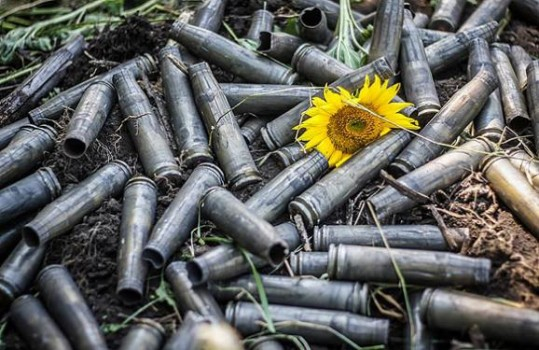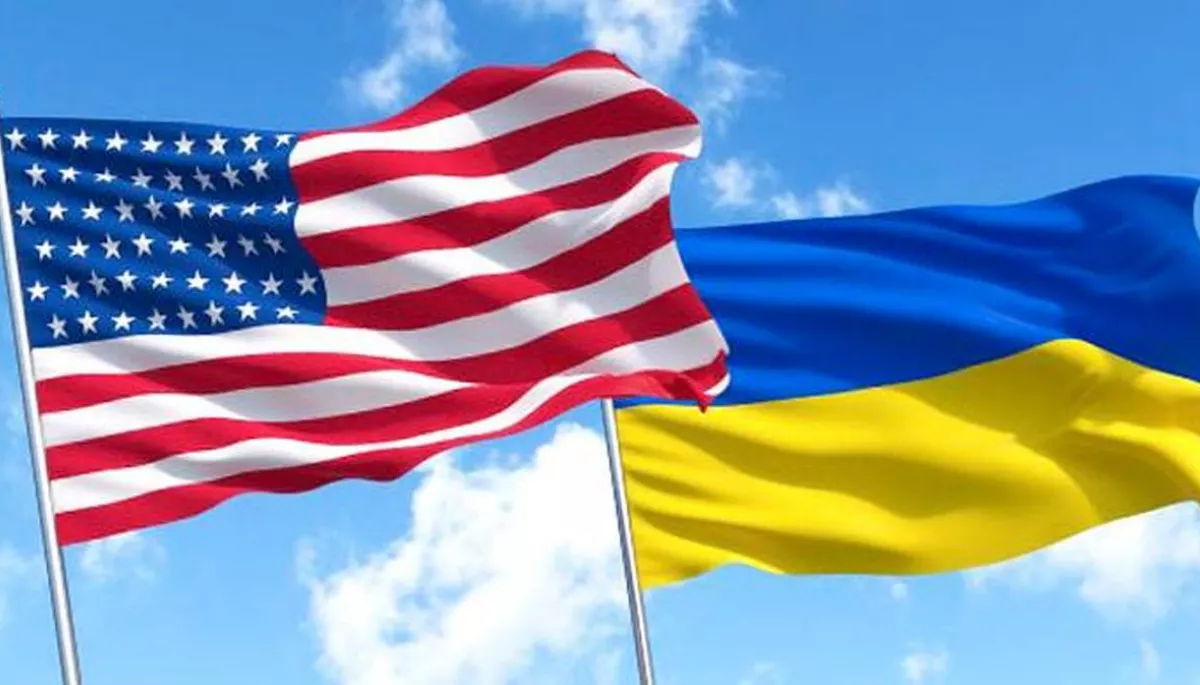
Clichéd war


The viewers of Ukrainian TV-news have the impression that the only problem of the liberated and occupied territories is food, damaged houses and passes permitting free entering/leaving of the action area. The Donbas locals do not have any other problems and issues. Even the absence of work, like in Shirokino that previously made its living with fishing and servicing tourists, has been skated over only recently and not by all media.
For instance, almost 300(!) stories of 700 analyzed ones concerning the in-migrants and locals of occupied territories were about daily routine in the region. The journalists mainly did not dig into the matter and built their material following the cliché: shelling of a city/town – death toll and destructions – complaints of locals (sometimes they give dialogues from bomb shelters) – journalist’s value judgements and locals asking for peace. Let’s take a story of STB’s journalist Oleksiy Simakov of 3 February 2015 as an example.
The correspondent starts with inflaming passions: “This heart-broken lady has lost both of godfathers of her child. And these girls have lost their father. The day before a shell hit the street in Kudriumivka village. One man was chopping fuelwood, another was taking out the garbage. The both were killed at once.”
He turns to gore and makes the story more dramatic with the grief details from locals:
“A lady: ‘Godfather of my child got killed. He is the second one. The bodies were lying here. All these guts and blood. There are other three men killed in the village.’”
Then Simakov fuels tensions even more telling about the death of pets: ‘The owner of this house was buried yesterday. Today they bury his faithful dog. It was gravely wounded with a splinter. Tears and despair again. The grief has occupied every street.’
But the correspondent does not care about the matters of those alive in the village. He uses the same cliché again: ‘Locals bury neighbors and friends almost every week. The villagers show us the ruins and remember death almost near each of them.’
The story ends with the entreaty of a local lady: ‘Stop the war please. We want to live, our children’.
This scheme of story-telling about Donbas residents is used by all central TV-channels. And this reveals a range of important issues:
Shallow approach.
Since the broadcast time is expensive and the news services take an aim to ‘stuff’ a spot with as much information as possible, the viewers do not get answers to the questions posed by a journalist in the story. For instance: a story from an occupied village. Within a two-minute video a correspondent manages to tell in broad strokes about the courage of military (‘though the enemy attacks, the fellows do not give up…’) without explaining the actual situation; to give the floor to locals’ complaints about roads and smashed houses (‘the yard of this or that lady was hit by a shell’); and tends to finish the material with military that promise to stand to the end or send their best to their relatives. This is a classical model of stories from the frontline and liberated cities. However, we are not talking about all stories: some of them do have serious explanations.
Incorrect terminology.
The shallow approach to situation coverage allows the inadequately competent journalists to make stories about Donbas. So another no less important problem arises: the use of incorrect terminology.
Volunteer and right-protection organizations as well as professional journalists keep saying: the Donbas locals that have left the occupied territories cannot be called refugees. This is a completely different legal status. Refugees are the people who left their native country and took shelter in a foreign one. Ukraine is experiencing the internal migration so the only adequate term is forced migrants. But media people keep calling them refugees. This error was noticed in the news of all central TV-channels.
Military definitions have the same issue. The journalists knowing the subject believe that the viewer can tell the difference between the mortar fire and artillery attack, howitzers and other equipment. But that is not so. The information flow is so fast that the viewers must be constantly reminded and explained in understandable words what it is about.
The same is about the valuation judgements of correspondents: the stories about the conflict zone tell about ‘fierce fighting’, ‘last-ditch battle’ etc. But their meanings are not explained to the viewers. Moreover, the journalists often do not know the difference. So we would like to recommend media people to scrutinize the explanation of military terms by Andriy Kulykov, journalist and anchorman.
People get tired of the topic fast.
Last few months the number of materials about the occupied and liberated territories is decreasing constantly. Media people explain that the viewers are fed up with shelling so the information about combat actions progress is not given in separate stories but in communiqués from military. However the channels do not think over a lot about the content on in-migrants and residents of occupied and liberated cities, it is monotonous. The major attention over the first three months of 2015 was paid to the topics of cities destroyed by shelling, passes into/from the combat area and evacuation of locals from dangerous areas.
Unjustified generalizations.
The journalists keep making the same mistake: having spoken to few locals they generalized their words to be a position of the whole region. Like FAKTY of ICTV channel on 22.03.2015. The journalist used the valuation judgement and made undue generalization: ‘Donbas people still cannot understand who is the enemy. They keep living in Soviet clichés waiting for somebody to shape their future for them.”
An image of peaceful Donbass local in media
Since the majority of stories about Donbas is about grievances of locals, destroyed houses, dirty bomb shelters and hungry people, the viewers tend to discover the image of an average Donbas local as follows:
- he/she is dirty and can have any diseases (since the journalists do not tell if the locals have access to medical service, when and how they take a shower, what the hygienic condition of bomb shelters is. All in all, this kind of stories caused the factoid that the in-migrants bring tuberculosis);
- he/she does not manage his/her life hoping for external help (incessant communications about the humanitarian aid and comments by locals that ‘we survive due to this aid’, this is especially the case of “Ukraina” channel);
- he/she shows little promise (the channels practically do not show in-migrants’ success stories and their adaptation to new life beyond dangerous Donbas areas);
- he/she is time-server (this tends to be less but the media still broadcast materials about locals that do not support any of the parts and merely ask for peace; moreover, there are isolated stories about locals helping the army or each other).
What in-migrants and residents of occupied territories would like to see in the news?
The in-migrants and volunteer organizations are not satisfied with the work of channels: currently, the media do not meet the information needs of residents of liberated and occupied territories. These are the research results of international organization ‘Internews’. The researchers have spoken to the in-migrants and volunteers and learned about the information priorities of occupied territories residents.
1. How to evacuate: how one can get a pass to leave? Who can help to get out? Who will host ‘there’?
2. Practical life-saving information: up-to-date reports about safe/open roads, safety violations, passes, supply of provisions, open markets, new laws and regulations about fire protection.
3. Offered help: how, where and via whom one can get humanitarian aid, like food, hygiene items, medicines, blankets, kid’s wear, household goods, tarpaulin or materials to repair houses or public buildings.
Those who left the conflict area would like to learn:
1. How one can get aid: who, where and how can gen humanitarian aid, mainly, in terms of accommodation, food and employment, though local groups say that families ask for ‘everything’ from kid’s wear and legal assistance to household articles.
2. The search of missing people: recently, with the conflict escalation, the number of search request has increased.
This information also supports the results of another research conducted in the South and East by Kyiv International Institute of Sociology at request of Telekritika NGO.
Though the information needs of Donetsk and Luhansk regions residents differ drastically from what is broadcasted on TV. Evacuation is the most important issue for the residents of occupied regions. But the evacuation holds only the third place in the broadcastings about peaceful population of Donbas (we have counted about 60 such stories over the period in question). TV-people devoted the first place to daily routine of civilians under shelling (almost 300 stories), the second place to the in-migrants’ problems and way of life (three times less, i.e. about 100 stories).
They are followed, in terms of quantity of TV stories, the issues of passes between occupied and not-occupied territories and the humanitarian aid. And they are followed by isolated materials on other issues.
In February, the TV-channels gave the foreground to destroyed houses: the half of materials about Donbas was dedicated to bombed houses and hiding locals. For comparison: January had three quarters as much of such materials. Finally, in March, they evoked the co-existence of locals and military but it was not until the Kostiantynivka tragedy (a reminder: drunk military on armored vehicle drove into a mother with two kids, an 8-year old girl died). But these are single materials not giving adequate image of relations between locals and military.
What the TV-channels forgot
1. Work of residents of occupied territories and in-migrants. The media does not give enough information where ‘DPR’ and ‘LPR’ locals take money to buy food and how the forced migrants adapt to new realities. The media only tell about work of psychologists, modular houses and accommodation issues, stories about in-migrants travelling abroad or to liberated territories to have a holiday.
2. Pension tourism. Since the Government has taken decision not to pay pensions to those who did not register in the territory controlled by Ukrainian authorities, public officers are going to be stricter when checking the houses where in-migrants are registered. If they are not there, the pensions will not be paid. But we found few materials about this issue. TV-channels made short spots about the pension tourism, but it is unclear how the system works and how many people were refused pensions.
3. Relations between Ukraine supporters and ‘DPR’ and ‘LPR’ advocates. Among thousands of stories over the three months we did not manage to identify the one about relations between people with different views. There were some one-sentence mentions in general materials about combat actions.
4. Military in near-front zone. Relations with locals. This was evoked in March after the Kostiantynivka tragedy. Though the whole March had some dozen stories about this. Despite locals’ complaints about Ukrainian military, the TV-channels keep skipping this topic.
5. Safety of near-front cities. Fortifications, bomb shelters, etc. Involvement of civilians. Journalists tell about bomb shelters but very superficially. As about fortifications, they are often shown in the stories about Ukrainian soldiers. But we couldn’t find any information about participation of locals in fortifications construction.
6. How to treat those who voted at ‘DPR’ and ‘LPR’ referendum. These questions are still asked by soldiers at the front and their relatives at home, but the media keep ignoring and writing about this problem.
Topical issues for Donbas civilians
We have found a little more than ten stories about the medicine in 700 materials about the action area. Journalists are repeating in unison that Donbas suffers the humanitarian disaster but they do not show this. Destroyed houses and no food do not complete the humanitarian disaster. The three-month research did not detect any material about water sewage and waste management in occupied and liberated territories, who treats people in bomb shelters and the level of hygiene there.
One of the major question is where do they bury those killed by shelling if the bullets keep flying all over the cities and villages? Our colleague born in Luhansk region told us privately that in her native town people are buried between the houses in yards because bringing a body to cemetery is too dangerous. Moreover, 6 March, all central TV-channels broadcasted the information from Samantha Power, the U.S. Permanent Representative to the United Nations. She stated that 500 dead civilians had been found in basements in Debaltsevo. But none of our colleagues asked: are there any responsible military, volunteers or civil servants checking the condition of elderly or handicapped people so that they would not die due to the lack of their capabilities? There is also an associated topic of funeral arrangements: people keep dying in Donbas. So there should be coffins and lots on graveyards. Both the coffin and the lot are expensive. So there is somebody making huge money of deaths. But none of the channels has considered this issue.
Back before 2015, there were stories about pets left by owners, often in a leash, and about volunteers and military keeping such animals or bringing them to shelters. But the only information about retired and handicapped of Donbas is jeansa about contribution of humanitarian headquarters of ‘benefactor’ Rinat Akhmetov broadcast by ‘Ukraina’ on a daily basis. Staff correspondents of the humanitarian headquarters accompany volunteers to houses of handicapped and tell about difficulties of these people. So to say, they are left by the authorities and only food packages from Akhmetov save them. None of the channels has shown any story about any such help from the State.
Though the colleagues were proficient and proper to bring up an issue of medicines in drugstores in occupied territories; but these were isolated materials without explaining what happens to people that do not have money for medicines. If the State does not take charge of them then who does? Are there any cases of death due to the lack of medicines recorded?
The issues of co-existence of military and civilians, of civilians and insurgents are no less important. Such information is practically out of the Ukrainian TV picture.










